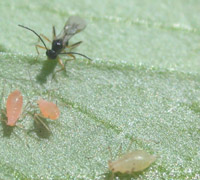
A parasitoid wasp stalks pea aphids so she can lay eggs in them. The wasp is a tad bigger than 0.01 inches long. Photo credit: (c) 2005 Kerry M. Oliver. Carrying the right bacterial hitchhiker can make the difference between life and death for an aphid. Pea aphids are often under attack by wasps seeking to lay their eggs inside aphids, turning them into an all-you-can-eat buffet for the larval wasps.
The aphids vary in their resistance to the wasps, which scientists had chalked up to genetic differences between aphids.
But it's not in their genes at all -- the wasp-resistant aphids owe their lives to the symbiotic bacteria carried inside them, according to new research.
"We knew there was a tremendous amount of variation in resistance to parasitism among different aphid lineages," said Kerry M. Oliver, lead author on the report. "We were definitely surprised � we assumed the bulk of the resistance was due to the aphids' genotype."
Figuring out what makes insects resistant to natural enemies is important to farmers. Pea aphids can be agricultural pests on plants in the pea family including lentils and peas.
The new finding suggests why some lineages of aphids readily succumb to the wasps and others don't.
"This work shows the difference can be attributed to the symbionts, not to the aphid genotype," said Oliver, a postdoctoral research associate in The University of Arizona's department of entomology and a member of UA's Center for Insect Science.
Oliver added that this implies aphids could acquire resistance to natural enemies by picking up bacterial symbionts, rather than having changes in the aphids' genes. Such a newly acquired resistance is heritable, because the bacteria get passed down from mother to her offspring.
The article by Oliver and his co-authors Nancy A. Moran, UA Regents' Professor of ecology and evolutionary biology, and Martha S. Hunter, UA associate professor of entomology, is published this week in the online early edition of the Proceedings of the National Academy of Sciences. The U.S. Department of Agriculture funded the research.
Many insects harbor bacterial symbionts that are passed from mother to offspring. LIttle is known about whether such symbionts can boost the host insects' resistance to natural enemies.
As part of his doctoral research in UA's Interdisciplinary Program in Insect Science, Oliver investigated the pea aphid, Acyrthosiphon pisum, an aphid known to vary in resistance to one of its major enemies, the parasitoid wasp Aphidius ervi. The aphids can also host one of several bacterial symbionts known as secondary symbionts.
One of his previous experiments indicated the symbiotic bacteria contribute at least some of the observed variation in resistance to the wasps.
"But we still thought most of the variation in resistance was due to the aphids' genotype," he said.
To tease out how much of the resistance was from the aphids' genes and how much from their symbionts, Oliver did another series of experiments. He took advantage of the fact that in the lab, aphids reproduce asexually -- female aphids produce more female aphids who produce more female aphids -- which means the offspring are identical genetically, generation after generation after generation.
Oliver injected several uninfected lineages of aphids with a secondary symbiont called Hamiltonella defensa. As a result, he had five genetically distinct colonies of pea aphids that all carried Hamiltonella defensa.
To test resistance to the wasps, he caged the different groups of infected aphids on individual fava bean plants by inverting plastic drink cups over the potted plants with aphids. Each plant had 30 aphids, all with the same bacteria inside.
Then he introduced a female wasp into each enclosure. Each wasp set about laying one egg per aphid in as many aphids as she could manage in the time allotted. Oliver removed the wasps after 6 hours.
Ten days later, he looked for evidence of wasp parasitism by counting the "mummies" -- the golden, hardened carcasses of aphids that had become homes for wasp larvae.
Oliver compared the rates of parasitism in uninfected aphids to infected aphids and found that carrying the H. defensa symbiont reduced parasitism by about 40 percent, no matter what the aphid's genotype.
He also did another experiment by taking uninfected aphids and injected them with various different secondary symbionts, so he had five colonies of pea aphids that were genetically identical but harbored different bacteria.
In this case, the infected aphids varied from 19% to almost 100% resistance, depending on which symbiont they carried.
The experiments show that aphids' variation in resistance to wasp parasitism stems from their bacteria, not their genes.
"Aphids are just completely nailed by natural enemies. Having these symbiotic defenders is really important to the aphids," Oliver said.
"Now we know symbionts confer resistance, but we don't know the mechanism of resistance -- we don't know the how." He said figuring that out is the team's next step.
Source : University of Arizona
 Print Article
Print Article Mail to a Friend
Mail to a Friend
